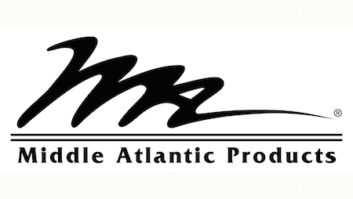
Part of Middle Atlantic’s PowerCool Series, the PDCOOL-1115R combines rack power distribution with surge protection and rack cooling.
You’ve spent years mastering your craft. As an integrator, you live at the intersection of art and science–that is to say, of human usage and technological capability. You understand your customers’ lifestyle and their wants/needs/expectations from the tech products in which they invest. You also understand technology and system design, selecting the brands and the products that most closely correlate to the needs and desires of your clients.
But experts say that many of you fail to adequately address one of the most important elements of the system that affects both its performance and its longevity. That element, which we call the “Final Frontier of System Performance,” is the need to proactively plan and control the thermal environment of your installations through passive and/or active cooling techniques.
Natural Born Enemies
Electrical engineers say that the biggest enemy of electronic devices is heat. Every electronic component or device has a recommended operating temperature range for optimal performance. If this range is exceeded, then the device’s performance will degrade. And if an excessive situation is not quickly remediated, the system will fall into thermal cycling. (Which, by the way, always seems to happen late on a Saturday night when your client has cranked the system up for some heavy special effects-laden movie to impress all of his or her friends. Guess who is first on their speed dial list when the system goes into thermal shutdown?)
We spoke to experts from several of the leading integration industry suppliers of cooling solutions to better understand the scope of the situation and to learn their recommendations for best practices that integrators should follow. Our experts for this article were: Frank Federman, CEO of Active Thermal Management; Christopher Franck, vice president of product development at SnapAV; Bret Leatherwood, product line manager for racks and cooling at SnapAV; Jamie Quinlan, project manager and engineer at SnapAV; David Lee, CEO of Cool Components; and Jay Franetovich, application specialist at Middle Atlantic Products. Cooling, they say, is the best way to ensure your clients are happy with the system today and remain happy with the system for five or more years down the road. And happy clients are your best prospects for new business in vacation homes, or system upgrades or expansions.

The Cool Components Advanced LT Temperature Controller provides On and Off control as well as variable speed control based on temperature. The Model VS-HFB is a cooling system popular with SnapAV integrators.
An Underutilized Necessity
While it might be true that the benefits of including cooling solutions might not be immediately obvious…they sometimes can be.
“I’ve walked up to racks where you couldn’t touch the rear door; it was so hot,” Middle Atlantic’s Franetovich said. “We’ve gotten calls where [integrators] literally said they practically burned their hands [on installations they were hired to fix].”
Think about the liability of that installation, when the client’s child touches a too-hot rack. That’s a call from either the client’s attorney, or your insurance company rep that you really don’t want to receive.
While most large residential integration companies have adopted cooling solutions into their regular installation planning, experts say that many smaller or mid-size integrators need to embrace these solutions in all, or most of their installations, as well. Rather than reserving cooling for “extraordinary” situations, a far greater number of systems should have cooling included as a matter of course.
“I think [cooling] is underused,” Franck said. “I think that the majority of racks that have fans associated with them, and we see this in our own numbers, I think it’s a pretty low percent right now. We’re at about 15 percent attachment today [of racks that ship with active cooling systems included],” both Franck and Leatherwood stated. “We think 40 or 50 percent is where we’d be fully attached.”
It’s Not Rocket Science, but It Is Science
Deciding to address the issue of cooling in your system design opens the door to a whole new collection of acronyms, such as CFMs and BTUs. But ATM’s Federman says you don’t have to become an engineer to add cooling. There are simple rules of thumb that will do the job.
“There is real science behind the need for cooling systems,” ATM’s Federman said. “But it’s not rocket science.”
The fundamental consideration is this: For every 10 degrees Fahrenheit in temperature increase over 85 degrees, the life of a digital component is reduced 40 percent. This rather arbitrary 85 degrees figure is an average recommended operating temperature for most electronic equipment. You can find this and other important facts in a whitepaper available on Middle Atlantic’s website, titled “Controlling the Temperature Inside Equipment Racks.”

“Components in a electrical device, such as a matrix switcher or a power supply, are like light bulbs: the hotter you run them the lower their life is,” added SnapAVs Franck.
Some modern components come with their own cooling systems, like built-in heat sinks and fans. Not only that, but today’s equipment is more efficient than the good-old-days of huge vacuum tube amplifiers, that at full gain could pretty efficiently fry an egg. Yep, put one of today’s new efficient amplifiers on an open shelf, all by itself, and it’s a happy camper. But put that amp in an enclosed rack, cabinet, or equipment closet that’s already loaded up with network switchers, cable/satellite boxes, and media servers, and you are setting the stage for a thermal disaster.
“Active cooling is always required when ventilation to electronics is being restricted,” Federman emphasized.
Make a Plan
Now that you are aware of the need to control the thermal environment of your installation, the first step is to look at your recommended system with this in mind. There are two ways you can do this. First, you can pull out the manufacturer’s detailed spec sheets for each product, find the recommended operating temperature range, look up the BTUs generated by each component, consider the anticipated demand load based on the customer’s likely use case, add them all up for a given rack of equipment, calculate the needed CFM of air to dissipate this heat build-up, pull out cooling system info, match up the details, etc.
Or, you can take the much simpler route. Remember Federman’s comment, “This isn’t rocket science?” Although some system designers will pursue the technical path suggested in the previous paragraph, the experts agree that you can get very close to this level of accuracy by simply using your common sense. And if you need help, most of these suppliers offer technical support personnel that are happy to advise you on your specific needs.

Middle Atlantic’s Comp-Cool50 is designed to cool an individual component.
Passive Thermal Control
The experts all agree that the best place to start in cooling is with passive thermal control. Passive systems generally involve installing properly positioned vents into the rack or cabinet to facilitate convection cooling with good airflow.
In your eighth grade science class, you learned that heat rises. This is a core principle of convection cooling. In a passive cooling system, you typically place a front-facing vent somewhere at or near the bottom of the rack. This lower vent will pull in the cooler, environmentally controlled ambient air. Then you place another vent at the top of the rack, typically somewhere on the back or side, where the hot air will exit the installation. Passive systems are inexpensive, effective, and have the added benefit of being completely silent.
“Just follow the principles of cooling,” said Cool Components CEO David Lee. “Work with the fact of heat rising, get good air flowing through, work with [component] spacing where you can. Just use common sense on how air travels.”
Active Thermal Control
Are you loading up a rack with high-intensity network switchers, hot-running media servers, and stuffing a piece of equipment into each and every rack unit space available? Then you are definitely in need of an active cooling system, most likely with a temperature-activated, variable-speed fan setup, perhaps even multiple fans.
Active systems essentially power up the convection cooling process and more actively pull out the hot air and lower the in-rack air pressure to efficiently suck in the cooler, room-temperature air from outside the rack.
Active cooling systems are what most people think of when they think of cooling systems. Looking at a range of cooling system suppliers, it can seem like a confusing array of products. Most of these systems, however, are similar and work in much the same way.

Are you putting equipment racks in a closet with no HVAC connection? You need a specialized solution, like this one illustrated by Middle Atlantic Products, which incorporates a blower and flexible hose to vent into an attic.
Here are some facts about active cooling for your consideration:
Cooling system fan noise is an important factor to your clients. Most suppliers rate their systems for noise in decibels (dB), and you want the lowest level of noise that moves enough air to keep the system cool.
An equipment rack that is stuffed with electronics generates more heat and, therefore, requires a cooling system that can move more air, measured in CFM (cubic feet per minute). Larger or more powerful fans move more air efficiently. The goal is to match the amount of cooling with the amount of heat needed to be exhausted.
Be aware that there is a tradeoff between noise and efficiency. The more air you need to move, the bigger the fans, and the more noise generated. “I would consider this a 50/50 issue,” Lee said. “Fifty percent is noise, 50 percent is effectiveness. If your product’s effective but noisy, nobody wants it; and the other way around as well.”
There are two main types of fans: AC- and DC-powered. AC fans tend to be more powerful and can move more air, but also are noisier. DC fans are quieter, but often move less air. A big advantage with DC fans is that their speed can be variable, so that when combined with a temperature control unit, can efficiently match the fan speed with the temperature level. And with brushless or low-friction bearing designs, they can be whisper silent.
Most cooling brands offer thermostatically controlled systems that match the amount of cooling with the in-rack temperature level. Initially, the fan will come on at a fairly low temperature, such as 85 degrees, running slowly/quietly. Then, as the system heats up, the fan speed will increase. All of the suppliers interviewed for this article offer some form of that type of system.
Most of the cooling system suppliers also offer a set of common cooling solutions. This includes vents (in a variety of colors and finishes), component cooling products (to cool a specific component such as an AV receiver), and fans. Middle Atlantic also offers quiet blowers that have greater capacity to pull air into a stuffed rack.
Are you putting equipment racks in a closet with no HVAC connection? You need a specialized solution that incorporates a blower and flexible hose to vent into an attic. This is one example of the many specialized products cooling suppliers offer. If you have a heating issue, most suppliers have a product for it.
Cooling solutions should be built into almost every system that integrators create. On smaller installations, a passive solution will do the trick, while on larger installations an active cooling system is necessary. But most importantly, adding cooling solutions clearly demonstrates to your customers that you are protecting their investment.
“Cooling is one of the most identifiable things that, when you run it by a customer, they can identify with,” Lee said. “They hear cooling, and they know that electronics generate heat,” so they intuitively understand that you are protecting their system.




